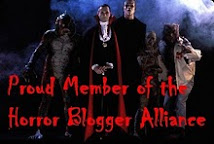When you give your book a title like The Slasher Movie Book, you're inviting an army of rabid horror nerds to attack it, rip it apart, and pick at the scraps until they complain about the fatty bits. Even though I'm merely a passing fan - heck, almost a guilty fan, considering how often I'm all like "Oh man, I don't like slashers; slashers are dumb; slashers are inferior; blah blah blah I'm trying to be intellectual blah" - of the subgenre, I took on the opportunity to review The Slasher Movie Book with a bit of trepidation. I know enough about horror to know when someone's missing important details, and I didn't want to be that guy who calls out an author over missed points.
So, it is much relief that I can admit that I know much less about the slasher film than J.A. Kerswell, the writer who complied this entirely thorough look at the movement in horror. Kerswell makes the case that the slasher had its "Golden Age" from 1978-1984, and I must also admit that my mind first thought this to be a surprisingly brief time period. After all, A Nightmare on Elm Street happened in 1984 and spawned many sequels and knockoffs, and we know that the Friday the 13th and Halloween franchises ran through the end of that decade. But Kerswell is very thorough in breaking down all aspects of the slasher's lifespan, and the case he makes for the time period listed is entirely reasonable once you get into his analysis.
However, a book on the slasher would not be complete if it only covered a six year span, and Kerswell knows this all too well. I expected nothing less from the author - who founded and runs the fantastic site Hysteria Lives! - but I equally underestimated the time range that the book would cover. A lot of folks like to trace the slasher back to Psycho - a fair assessment, and I assure you that Hitchcock's film is featured in this book - but Kerswell goes much farther than that. In fact, the book ends up covering a span of time that dates back to (at least) 1897(!) and covers the progress of the slasher straight through recent remakes like Sorority Row, My Bloody Valentine, and of course Friday the 13th and A Nightmare on Elm Street.
While chronicling the timeline that runs prior to, within, and beyond the slasher's Golden Age, the author leaves no stone unturned. I was floored to find a chapter on the German "krimi" movement, a precursor to Italy's giallo, that I had frankly never even heard of in my travels through film history. Kerswell also opened my eyes to plenty of other films that predated the tradition slasher, ranging from the obscure - he got me to hunt down 1962's Violent Midnight, produced by fellow Iowan and favorite of mine Del Tenney - to the obvious, like Michael Crichton's Westworld (a movie I've seen a dozen times but never considered as an inspiration to Halloween until just now). There's also some well deserved recognition for Britain's Pete Walker, and of course an indepth discussion of the giallo the covers Bava, Argento, and the rest of the gang.
But really, the meat-and-potatoes of the book is when Kerswell starts to roll through that Golden Age, breaking down the slasher year-by year and covering the production, reception, and fiscal gains of what seems like hundreds of films. It was incredibly difficult for me to get through this section - well, to get through most of the book, really - without having to take breaks to look up some of these films on IMDB or Amazon. (Don't worry mom, I didn't break the bank.) The presentation bounces through the trends in the subgenre and details which films were influential upon which films, creating this big spider-web of knowledge that shows how much these films relied upon the same ideals.
Kerswell's writing throughout the book is informative, if not repetitive (as someone who writes about horror, I definitely understand that there aren't a billion ways to describe some hack-and-slash), and he throws in plenty of interesting tidbits about the cast members and filmmakers behind the horror. My mind was particularly blown when he discussed the fact that 1984's Fatal Games was made (in part) by the sons of legendary directors Luis Bunuel and Joseph L. Mankiewicz, and his description of some of the sillier slasher films was equally entertaining. Few film descriptions have raised my eyebrows more quickly than when Kerswell revealed that the plot 1982's Blood Beat "seemed to have a seven-foot-tall samurai conjured up by female masturbation", yet Kerswell pulls that one off masterfully. (No, I did not buy that movie - but it wasn't for lack of trying.)
Packed full of poster/VHS images for all kinds of horror films, The Slasher Movie Book is as good looking to a horror fan as it is informative. I had minor quibbles with some of the choices of page color - black text on a dark red or purple background is a little difficult to read in the darkness of my lair, but I bet overhead lighting would have helped with that - but the presentation is generally fantastic and this could easily shine as a coffee table item for a horror lover's home theater.
Combining all factors together, there's no reason a horror fan shouldn't check out The Slasher Movie Book. There's a lot to be learned from Kerswell's dissection of his topic, and the addition of an index, glossary, review section, and more to the end of the book should make it a nice reference for the horror scholar. The book is now available through Hysteria Lives or directly at Amazon, and anyone who wants to enrich their understanding of horror's stabby subgenre should jump on the book immediately.
Stream Me!
1 day ago











No comments:
Post a Comment